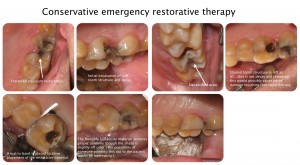This emergency patient presented with a fractured amalgam restoration. The tooth was asymptomatic and a radiograph showed no obvious pathology. The following therapy was performed. Local anesthesia was administered (topical plus septicaine). Removal of the amalgam and soft tooth structure was performed. The pulpal floor had an amalgam stain but this was hard tooth structure and was left as is. It was also noted that the adjacent mesial surface of the second molar had a decalcified area (pre-carious). Following placement of the composite restoration on the first molar and due to the extensive loss of tooth structure there was an open contact between these two molars. The simplest and most logical way to close this space (and rectify the decalcified area) would be to restore the second molar with a durable amalgam restoration.
The decision to restore the first molar with a composite rather than a crown restoration was based on several factors:
- The patient was on vacation here in Miami Beach and appreciated a more conservative therapy.
- Conservative therapy is in general a superior method of therapy. The patient could always have a crown restoration performed in the future if necessary.
- It is unfortunate that many dentists choose a more expensive alternative as strictly a business decision.


